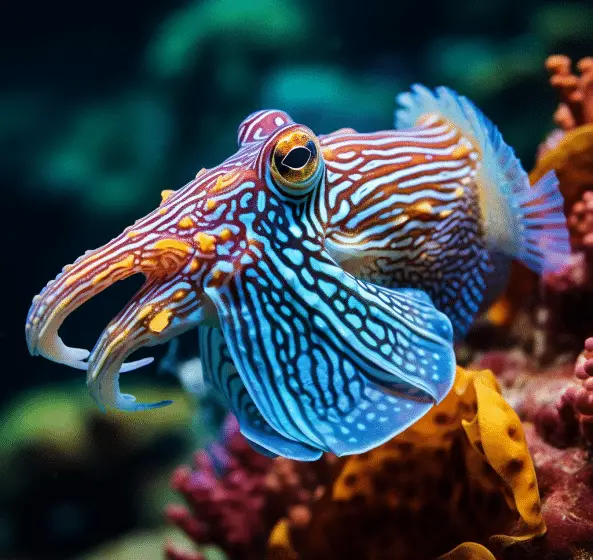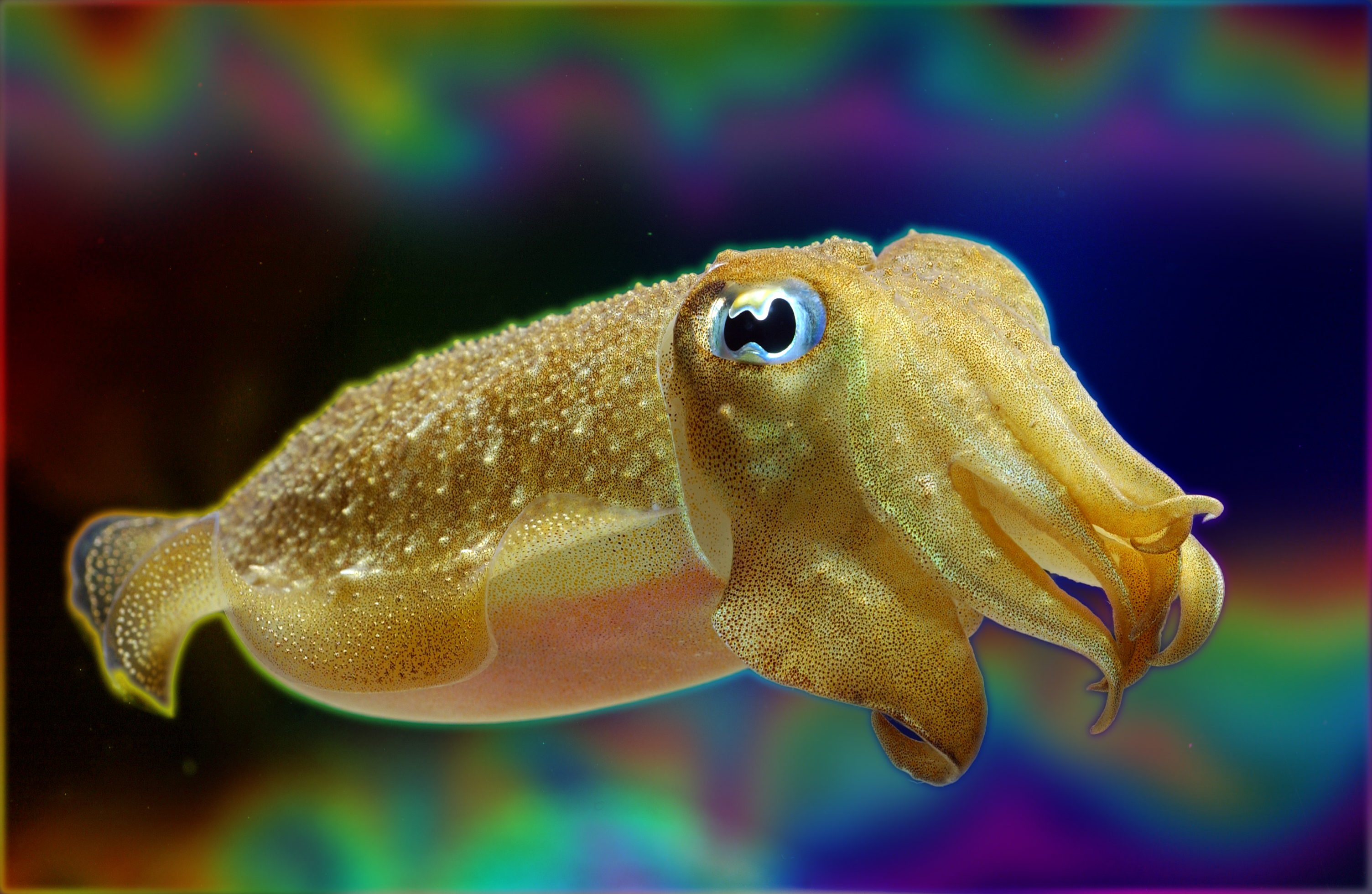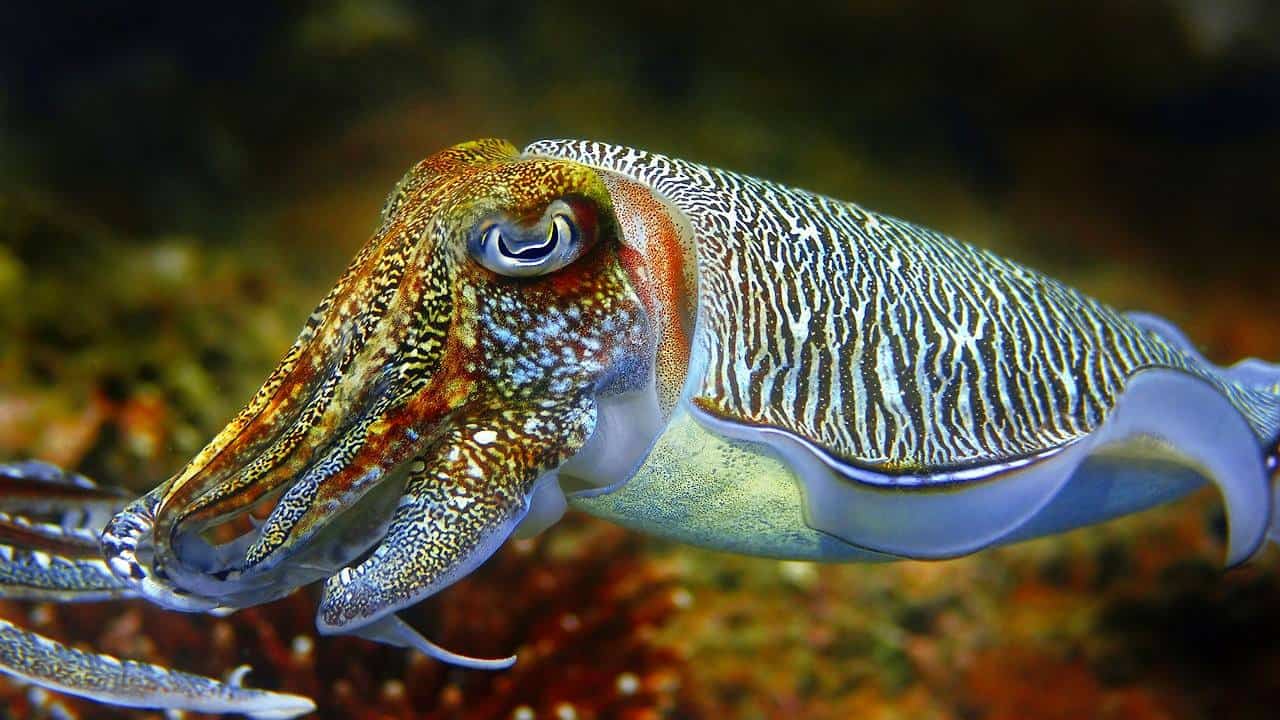Cuttlefish Cephalopods: Understanding Their Role in Marine Ecosystems

Introduction
Are Cuttlefish Cephalopods: Cuttlefish are clearly cephalopods due to their shared features. Soft, elongated bodies, complex neurological systems, and arms or tentacles distinguish cephalopods like squids and octopuses. Cuttlefish share these traits. They have eight arms and two larger tentacles with suckers and hooks, enormous brains that permit intelligence and complicated behaviors, and streamlined bodies. This places them in the cephalopod class, where they excel as marine animals.
Cuttlefish have unique features as well as many cephalopod traits. They differ from others due to their cuttlebone buoyancy control. This modification helps cuttlefish maintain precise water column depths, giving them an advantage in their marine surroundings. They control their cuttlebone’s gas concentration better than squids or octopuses. Cuttlefish have a unique fin-jet propulsion system that gives them finesse and agility underwater. Their well-developed eyes emphasize their visual acuity and importance in hunting and communication.
Cuttlefish are cephalopods due to their body form, neurological system, and unique appendages.The cuttlebone and swimming ability are evidence of their cephalopod evolution. Cuttlefish thrive in the fascinating underwater realm, adding to cephalopod diversity.

Is a cuttlefish a cephalopod?
The Cephalopoda group includes octopus, squid, cuttlefish, nautilus, and others. The Greek word “cephalopod” means “head foot,” which perfectly describes animals with eyes above their many limbs.
Yes, cuttlefish are cephalopods. Cephalopods are fascinating marine animals with advanced intelligence, unique features, and powerful abilities. This class includes cuttlefish, squids, and octopuses.
Cuttlefish share many traits with other cephalopods. They have soft bodies, prominent heads, and powerful tentacles with suckers and hooks. Their highly developed nervous system allows for complex behaviors, and they can change color and texture for camouflage, communication, and hunting in the ocean.
These fascinating cephalopods have unique traits and behaviors that make them stand out in the marine world. While all cephalopods are remarkable, cuttlefish’s unique traits and behaviors have drawn scientists, naturalists, and enthusiasts.
What makes a cuttlefish a cephalopod?
Cephalopod literally means ‘head foot’ and members of this group, including octopuses, cuttlefishes, squids and nautiluses, have their foot or tentacles connected to their head, not their body. Cephalopods have the most advanced nervous system of all invertebrate animals and are active hunters.
Several key characteristics make a cuttlefish a cephalopod. These features place cuttlefish within the class Cephalopoda, which is a subgroup of the mollusk phylum. Cephalopods are highly advanced and intelligent marine organisms, and cuttlefish share some qualities with them.
- Soft Body: Like all cephalopods, cuttlefish have a soft, elongated body, which distinguishes them from other mollusks like snails and clams. Their body structure is well-suited for a marine lifestyle, allowing for streamlined movement in the water.
- Advanced Nervous System: Cuttlefish, along with other cephalopods, possess a complex and highly developed nervous system. Their large brains enable them to exhibit intricate behaviors, including problem-solving, learning, and sophisticated hunting tactics. Their intelligence is notably higher than that of most other invertebrates.
- Specialized Appendages: Cephalopods are characterized by their specialized tentacles or arms, which often have suckers or hooks. In the case of cuttlefish, they have eight arms and two longer tentacles equipped with sucker-bearing structures. These appendages are used for hunting, manipulating prey, and capturing food.
Cuttlefish are cephalopods due to their acute vision, beak-like mouth, and other traits. Cuttlefish, like squids and octopuses, are cephalopods with unique traits and behaviors.
The Ecological Importance of Cuttlefish
Cuttlefish play a significant role in marine ecosystems, contributing to the balance of underwater environments. As both predators and prey, they occupy a unique niche in the food web. Cuttlefish primarily feed on small fish, crustaceans, and other marine organisms, using their exceptional camouflage and hunting skills to capture prey. This predatory behavior helps regulate the populations of their prey species, maintaining ecological balance within their habitats.
Moreover, cuttlefish are an essential food source for various larger marine animals, including sharks, rays, and seabirds. Their role as prey is crucial for the survival of these species, highlighting the interconnectedness of marine life. Additionally, cuttlefish contribute to nutrient cycling in the ocean through their feeding habits and excretion, promoting healthy ecosystems.
Understanding the ecological importance of cuttlefish enhances our appreciation of their role in marine environments and emphasizes the need for conservation efforts to protect these fascinating cephalopods and their habitats from overfishing and environmental changes.
Is a cuttlefish a mollusk or a cephalopod?
Cuttlefish or cuttles are marine molluscs of the order Sepiida. They belong to the class Cephalopoda which also includes squid, octopuses, and nautiluses.
A cuttlefish is both a mollusk and a cephalopod. Mollusks represent one of the largest and most diverse phyla in the animal kingdom, encompassing various organisms such as snails, clams, and octopuses. Cuttlefish belong to this phylum, Mollusca. Within the phylum, cuttlefish are classified as cephalopods, a specialized class of mollusks.
Cephalopods are a subgroup of mollusks known for their advanced adaptations, intelligence, and remarkable characteristics.Cuttlefish, like squids and octopuses, have soft, elongated bodies, well-developed nerve systems, and tentacles. These features are what distinguish them as cephalopods within the broader classification of mollusks.
Cuttlefish, one of the mollusk phylum’s cephalopod class, are intriguing and highly evolved marine invertebrates with color-changing powers, intellect, and unique biochemistry.
What is the difference between mollusks and cephalopods?
The most obvious difference between most cephalopods and other mollusks is the apparent lack of a shell. Octopuses do not have shells at all, while squids have a small internal shell. (Nautiluses, which are found in the South Pacific and Indian oceans, are the only cephalopods with an external shell.
Mollusks and cephalopods are both classifications within the animal kingdom, specifically within the phylum Mollusca. However, there are significant differences between these two groups.
- Scope and Diversity: Mollusks represent one of the largest and most diverse animal phyla, comprising a wide range of organisms. This phylum includes not only cephalopods but also other well-known mollusks like snails, clams, and oysters. Cephalopods, on the other hand, are a highly specialized class within the Mollusca phylum. Unlike the diverse body plans of many mollusks, cephalopods typically have a more streamlined and ocean-adapted form with advanced features.
- Advanced Characteristics: Cephalopods are known for their advanced characteristics, such as highly developed nervous systems, complex behaviors, and specialized structures like tentacles equipped with suckers. They are renowned for their intelligence and extraordinary adaptations, such as the ability to change color for communication and camouflage. In contrast, other mollusks, while diverse, generally lack the level of intelligence and specialized structures seen in cephalopods.
While both mollusks and cephalopods belong to the same phylum, their differences in diversity, advanced characteristics, and habitat preferences set cephalopods apart as a unique and fascinating class within the mollusk family.
Is a cuttlefish a squid or octopus?
Squid have longer, cylindrical bodies; cuttlefish are spoon-shaped; and octopus have round heads and larger tentacles.
Cuttlefish are Cephalopods, although they are not squids or octopuses. While cuttlefish, squids, and octopuses are related, they have significant traits that set them apart.
Squids, on the other hand, have elongated bodies, ten tentacles, and a distinct cylindrical shape. They are highly skilled swimmers, propelled by powerful jet propulsion. Squids also have a more external and reduced shell, called a pen, in comparison to cuttlefish.
Octopuses differ from both cuttlefish and squids due to their lack of an external or internal shell. They have a soft, bag-like body with eight long, flexible arms, and they are known for their intelligence, problem-solving abilities, and adaptability. Octopuses are typically benthic, meaning they dwell on the seafloor.
While cuttlefish, squids, and octopuses share the classification of being cephalopods and possess remarkable features for life in the ocean, their unique adaptations and characteristics make them distinct from one another within this diverse group of marine animals.
Are cuttlefish considered cephalopods like squids and octopuses?
Yes, cuttlefish are indeed considered cephalopods, just like squids and octopuses. Cephalopods represent a remarkable class of marine animals known for their advanced adaptations, intelligence, and distinctive features. This classification includes cuttlefish, squids, octopuses, and some lesser-known groups.
All cephalopods share several defining characteristics, which set them apart from other animals. These include a soft, elongated body; a prominent head; and specialized appendages, often in the form of tentacles or arms equipped with structures like suckers and hooks. Additionally, cephalopods possess advanced nervous systems, enabling complex behaviors, learning, and problem-solving abilities, which contribute to their reputation as some of the most intelligent invertebrates.
While cuttlefish, squids, and octopuses are part of the same cephalopod class, each group exhibits its unique adaptations and behaviors, making them fascinating subjects of study and wonder in the world of marine biology. Their shared classification highlights the diversity and complexity of life within the ocean’s depths.
What are the defining characteristics that classify cuttlefish as cephalopods?
Cuttlefish belong to the class Cephalopoda, a group of highly specialized marine animals known for their remarkable adaptations and behaviors. Several defining characteristics solidify cuttlefish’s classification as cephalopods, setting them apart from other organisms within the animal kingdom.
One of the key defining features is their soft, elongated body, which is a shared characteristic among all cephalopods. Cuttlefish, like squids and octopuses, have streamlined bodies that are well-suited for life in the ocean. These bodies differentiate them from other mollusks, such as snails or clams, which often have shells or diverse body shapes.
Another defining trait is their advanced nervous system. Cuttlefish, like other cephalopods, possess large brains that enable them to display complex behaviors and intelligence. These remarkable cognitive abilities, including problem-solving and learning, are hallmarks of cephalopods.
Furthermore, cephalopods, including cuttlefish, have specialized appendages that set them apart. Cuttlefish are equipped with eight arms and two longer tentacles, each adorned with suckers and hooks. These appendages are vital for capturing prey, manipulating objects, and sensing their environment. This feature is a defining characteristic of cephalopods and highlights their role as skilled and adaptable marine hunters.
Cuttlefish’s classification as cephalopods is based on a combination of shared characteristics like body structure, advanced nervous systems, and specialized appendages. These defining features emphasize their place within the fascinating world of cephalopods, where their unique adaptations and behaviors contribute to the rich diversity of marine life.
How do cuttlefish’s cephalopod traits differ from those of other cephalopods like squids and octopuses?
Cuttlefish share many cephalopod traits with their close relatives, squids and octopuses, but they also have distinct features that set them apart.
One key difference is the presence of a cuttlebone in cuttlefish, which acts as a buoyancy control organ. This internal structure is not found in squids or octopuses. Cuttlefish can manipulate the cuttlebone’s gas content to adjust their buoyancy, allowing them to maintain specific depths in the water column, which is a unique adaptation.
Even though all cephalopods are good swimmers, squids have the most powerful jet propulsion because their bodies are long and smooth. Octopuses mostly crawl on the seafloor and have bodies that are rounder and bulbous. Cuttlefish bodies are a little shorter and thicker than squid bodies. They are also very good swimmers and can use both fin propulsion and jet propulsion to keep precise control over their movements.
Cuttlefish are also known for having eyes that are very developed and complicated. Some octopuses and some squids also have eyes like this. They can see very clearly with their eyes, which they use for hunting, finding their way, and talking to each other.
While cuttlefish, squids, and octopuses belong to the cephalopod class, each group possesses unique adaptations and features that suit their specific lifestyles and needs in the marine environment. These distinctions make the cephalopods a diverse and fascinating group within the animal kingdom.

Conclusion
There is no doubt that cuttlefish are unequivocally classified as cephalopods. The class Cephalopoda encompasses a diverse group of marine animals known for their advanced adaptations, intelligence, and remarkable features. Cuttlefish stand as prominent representatives of this class, sharing numerous defining traits with their close relatives, such as squids and octopuses.
From their soft, elongated bodies to their highly developed nervous systems, including their large brains, cuttlefish exemplify the hallmarks of cephalopods. Their specialized appendages, in the form of arms and tentacles equipped with suckers and hooks, are key features that place them firmly within this class. The advanced behaviors, problem-solving abilities, and intelligence they exhibit are further proof of their cephalopod lineage.
While cuttlefish exhibit shared characteristics with other cephalopods, they also boast unique adaptations that distinguish them. The presence of a cuttlebone for buoyancy control, their swimming capabilities, and their highly developed eyes highlight their individuality within the cephalopod class.
The classification of cuttlefish as cephalopods not only emphasizes their place in the natural world but also underscores their role as captivating and intelligent marine creatures, contributing to the intriguing diversity of life within the ocean’s depths. They are a testament to the wonder of evolution and the interconnectedness of all life forms on Earth.



